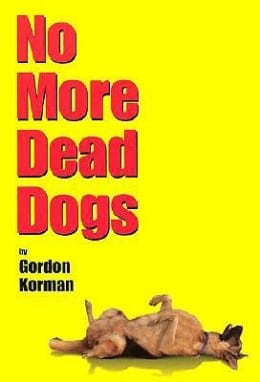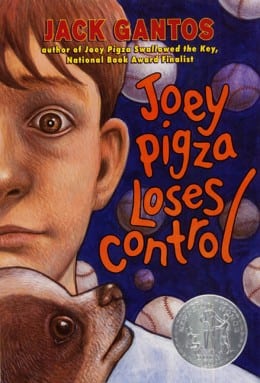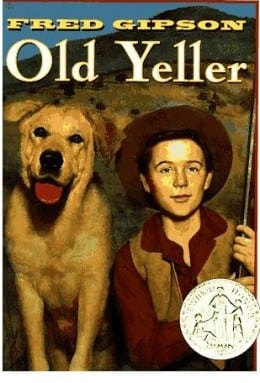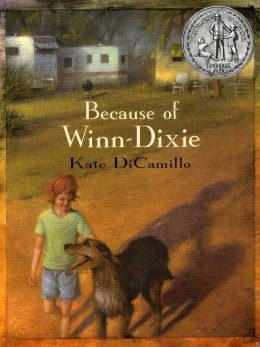 I first started thinking about “dog books” when I was working on my MFA for Vermont College of Fine Arts. I was working on two different fictional pieces in which a dog was central to the story. I was asked, more than once, if the dog was going to die. It was a reasonable question; after all, haven’t we all had our hearts broken over the death of a beloved dog character? As Wallace Wallace points out in Gordon Korman’s novel, NO MORE DEAD DOGS, “the dog always dies. Go to the library and pick out a book with an award sticker and a dog on the cover. Trust me, that dog is going down.” I started thinking about the fictional deaths of trusty dogs—and also, about the stories where the pet dog doesn’t die.
I first started thinking about “dog books” when I was working on my MFA for Vermont College of Fine Arts. I was working on two different fictional pieces in which a dog was central to the story. I was asked, more than once, if the dog was going to die. It was a reasonable question; after all, haven’t we all had our hearts broken over the death of a beloved dog character? As Wallace Wallace points out in Gordon Korman’s novel, NO MORE DEAD DOGS, “the dog always dies. Go to the library and pick out a book with an award sticker and a dog on the cover. Trust me, that dog is going down.” I started thinking about the fictional deaths of trusty dogs—and also, about the stories where the pet dog doesn’t die.
As I began to read more stories featuring dog characters, I realized how fully dog characters can enrich our stories, regardless of their fates. They are far more than a furry prop.
Although dogs appear in stories for readers of all ages, I personally think middle grade literature is the sweet spot. These characters—and readers of these books—are often at a threshold, nearing the end of childhood and peeking around the corner at adulthood. A loyal dog can be the perfect companion to accompany a character as they venture out into the world for the first time. He can be a protector, providing a sense of security; and yet a dog also needs care and attention. He needs the child owner as much as the child needs the dog. A child-pet bond has the potential for being the first significant, mutual relationship in a person’s life.
 Here are some of the ways a secondary dog character can enrich a story:
Here are some of the ways a secondary dog character can enrich a story:
- AN ALLY FOR THE MAIN CHARACTER: Quite simply, a dog is a friend. If a main character is isolated for some reason—whether it’s for geographic or emotional reasons—the dog sidekick is someone for the main character to talk to and explore with. Because dogs are familiar, readers easily accept dog characters without a lot of extensive backstory required. Simply assign a breed, and readers will already feel as if they have some understanding of this who this dog will be. For instance, Joey Pigza’s Chihuahua, Pablo, is a very different dog than scrappy Old Yeller.
 EMOTIONAL THERMOSTAT: Often times a main character will project his/her feelings on to that of the loyal canine sidekick. As a story progresses, readers can gain a deeper understanding of exactly how the main character feels in certain situations through various interactions and conversations with the dog companion.
EMOTIONAL THERMOSTAT: Often times a main character will project his/her feelings on to that of the loyal canine sidekick. As a story progresses, readers can gain a deeper understanding of exactly how the main character feels in certain situations through various interactions and conversations with the dog companion.
- SETTING: Dogs need contact with the outside world. This necessary stepping out allows the setting to be revealed and explored in an organic and relevant manner. Whether it’s the wilderness of the Ozark Mountains or Wyoming; a small town in Florida or a suburb of Pittsburgh, a dog is going to lead his child owner out and about.
 PLOT: A pet dog can serve as an authentically motivating factor for the main character, or as an impetus for plot events. Because dogs are sentient beings, a dog takes action. He often leads a human character into a new and unexpected situation. Although intelligent and capable, dogs are also prone to ridiculous exploits: rolling in messy substances, chasing other animals, and other impulsive misbehaviors. This mischievousness helps to make them intrinsically interesting and entertaining.
PLOT: A pet dog can serve as an authentically motivating factor for the main character, or as an impetus for plot events. Because dogs are sentient beings, a dog takes action. He often leads a human character into a new and unexpected situation. Although intelligent and capable, dogs are also prone to ridiculous exploits: rolling in messy substances, chasing other animals, and other impulsive misbehaviors. This mischievousness helps to make them intrinsically interesting and entertaining.
 THEME: Due to the intense bond forged between a child and his or her dog, this relationship can effectively force a character into making some tough decisions. Through the experiences they share, lessons may be learned. Characters may be forced to cross that threshold into adulthood. A dog is an ideal companion when a character comes of age.
THEME: Due to the intense bond forged between a child and his or her dog, this relationship can effectively force a character into making some tough decisions. Through the experiences they share, lessons may be learned. Characters may be forced to cross that threshold into adulthood. A dog is an ideal companion when a character comes of age.
Which leads me back to that initial question: Why do so many dogs die in stories for middle grade readers? Well, it seems to me, in many ways a dog can serve as a symbol for childhood. Dogs are often loyal and loving, trusting and forgiving, and blessed with a joyful, enthusiastic spontaneity that leads to a willingness to explore, make noise, and get messy…all traits that inherently childlike.
So, when a main character crosses that line, leaving childhood behind, the dog passes away. In the classic boy and his dog story, OLD YELLER by Fred Gipson, once Travis proves that he is capable of taking care of his family during his father’s long absence, then he must say goodbye to the mangy old mutt that helped him to do so. But Opal, in BECAUSE OF WINN-DIXIE by Kate DiCamillo, has been forced to act in a grown up manner too early due to her mother’s abandonment. What she needs most is for her father to take care of her a little longer. And so, Winn-Dixie lives on, even after his worrisome disappearance.
 Loved in spite of their faults, dog characters can serve as a kind of touchstone for children. They are living, panting proof that we are lovable, even when we make mistakes.
Loved in spite of their faults, dog characters can serve as a kind of touchstone for children. They are living, panting proof that we are lovable, even when we make mistakes.
BIO:
Sarah Tomp lives in San Diego California with her family, including Luna, a sweet black mutt. Her YA novel, MY BEST EVERYTHING will be published by Little, Brown Books for Young Readers in March 2015. She is also the author of a picture book, RED, WHITE AND BLUE GOOD-BYE (Walker and Co.). She has a MFA from VCFA. Please visit her at www.sarahtomp.com


